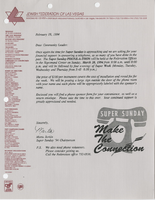Search the Special Collections and Archives Portal
Search Results
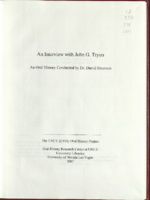
Transcript of interview with John G. Tryon by Dr. David Emerson, February 21, 2006
Date
Archival Collection
Description
Text
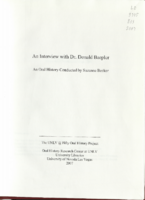
Transcript of interview with Dr. Donald Baepler by Suzanne Becker, April 23, 2007
Date
Archival Collection
Description
Text
Marc Wilkinson Papers
Identifier
Abstract
The Marc Wilkinson Papers contain materials related to the business and personal life of Marc Wilkinson, his wife Theresa, and their printing business, Marc Wilkinson Printer located in Las Vegas, Nevada, from 1953 to 1980. The collection includes business correspondence, business advertisements, and materials relating to membership in Las Vegas social organizations.
Archival Collection
Miss Nevada U. S. A. Pageant Programs
Identifier
Abstract
The Miss Nevada U.S.A. Pageant Programs contain souvenir programs from the Miss Nevada U.S.A. Pageants held at the Holiday Casino in Las Vegas, Nevada from 1981 to 1985. These programs showcase the pageant contestants and feature advertisements from event sponsors. The collection also contains one souvenir program from the Miss Nevada Teen U.S.A. Pageant held in 1985.
Archival Collection
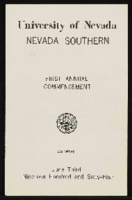
Nevada Southern University 1st commencement program
Date
Archival Collection
Description
Commencement program from University of Nevada, Las Vegas Commencement Programs and Graduation Lists (UA-00115).
Text
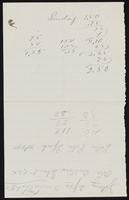
Stewart family banking records and receipts
Date
Archival Collection
Description
Stewart family banking records and receipts
Text

Transcript of interview with Brian Cram by Stefani Evans and Claytee White, October 28, 2016
Date
Archival Collection
Description
Throughout his career, former Clark County School District Superintendent (1989–2000) Brian Cram took his father's words to heart. He heard them repeatedly over the years as he watched and later, helped, his father clean classrooms at Robert E. Lake Elementary School: this place—the classroom—this is the most important place. Cram was born in Caliente, where his father worked on the railroad. In 1939, when Cram was a toddler, the family moved to Las Vegas and his father found work first as a sanitation engineer at a hospital, and then at CCSD as a custodian. The elder Cram, who spent his formative years in the Great Depression, prided himself on doing "good, honorable work" as a custodian, because the work—the classroom—mattered. Even so, he wanted more for his son. Cram largely ignored his father's advice during his four years at Las Vegas High School, where he ran with The Trimmers car club, wore a duck tail and a leather jacket, and copped an attitude. Cram's swagger, though, d
Text

Transcript of interview with Celia Rivero Grenfell by Patricia Hollard, March 31, 1977
Date
Archival Collection
Description
On March 31, 1977, Patricia Holland interviewed Celia Rivero Grenfell (born 1926 in Las Vegas, Nevada) about her life in Southern Nevada. Grenfell first talks about her family background in Mexico and later describes her family’s restaurant business. She also describes her education, recreational activities, Downtown Las Vegas, and Helldorado. The two also discuss racial segregation and prejudice, the El Rancho Vegas, Lorenzi Park, early churches, environmental changes, early air conditioning, and Grenfell’s early work in a laundry business.
Text

